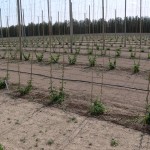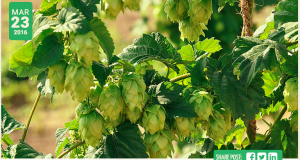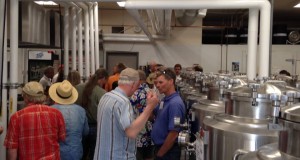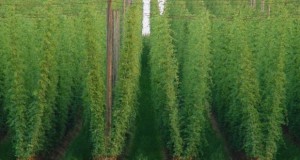By: Evan Elford – New Crop Specialist | OMAF/MRA | ONspecialtycrops | May 14, 2014
At this point in the season, many hop growers are quickly finishing up stringing their yards and beginning the training and pruning process. Depending on size of the hop yard and access to labour, allowing the bines to self-train may be an option for some growers to save time and money.
The UK Department of Hop Research published a report in 1973 based on five years of training trials with Petham and Eastwell Golding Hops. Field trials compared ‘normal hand training’ with plants that were permitted to ‘self-train’ up to a pre-determined height at which any empty strings in the self-training treatments were subsequently hand-trained with two bines.
In the first two years of the trial, normal hand training treatments had higher overall mean yields per hectare than self-training treatments with a mean yield of 2296 kg/ha (2050 lb/acre) for hand trained bines versus 2070 kg/ha (1848 lb/acre) for self-trained bines.
In the last three years of the trial, treatments were modified to overcome issues with high numbers of empty strings and low numbers of suitable shoots available to secure onto empty strings in the self-training treatments. Treatments in years 3-5 included:
1. Complete Self-Training;
2. Minimum Assisted Self-Training (self-training to a predetermined point with subsequent training on empty strings if required);
3. Maximum Assisted Self-Training (a handful of bines pushed around strings and left until growth had reached a predetermined height before securing bines to empty strings); and,
4. Normal Hand Training.
Yields from each of the three years (1969-1971) of modified treatments are summarised in Table 1.
Table 1: Adapted from Thompson, F.C., 1973 – Mean weight from 5 replicates of Pethem and Eastwell Golding Hops over three years (1969-1971) of training trials located in Wye, UK.
| Treatment | Weight kg/ha (lb/ac) | |||
| 1969 | 1970 | 1971 | 3 Year Mean | |
| Complete Self-Training | 2308 (2061) | 1467 (1310) | 1530 (1366) | 1768 (1579) |
| Minimum Assisted Self-Training | 2471 (2206) | 1556 (1389) | 1593 (1422) | 1873 (1672) |
| Maximum Assisted Self-Training | 2533 (2262) | 1430 (1277) | 1655 (1478) | 1873 (1672) |
| Normal Hand Training | 2509 (2240) | 1467 (1310) | 1718 (1534) | 1898 (1694) |
Article Observations
Although this study was published 40 years ago, the topic area is still applicable for current hop producers. In searching peer reviewed articles and research reports, this was the only study pertaining to training trials that could be found.
In the trials, yields from self-training treatments look encouraging (89-100% of normal hand training), however, a complete statistical analysis was not provided in the report and therefore one must be cautious when interpreting the results (note: means of 5 reps were reported in the data). Additionally, some important information pertaining to the methods were not included, such as the height at which self-training treatments were allowed to grow before intervention with hand training. These details would be required to successfully replicate the process on-farm.
Based on the results of this report, normal hand training still appears to be the best method for producing optimal yields in hops. However, the training trials do provide some insight into the expected decrease in yields if hop growers are unable to hand train their bines early in the season due to other farm activities.
References
Thompson, F.C. (1973). Training Trials with Golding Hops. Department of Hop Research Annual Report.
To read the original article, click here.
 Ontario Hop Growers' Association The OHGA is a not-for-profit association of hop growers, families and enthusiasts who are interested in supporting the growth of the hop industry in Ontario.
Ontario Hop Growers' Association The OHGA is a not-for-profit association of hop growers, families and enthusiasts who are interested in supporting the growth of the hop industry in Ontario.




